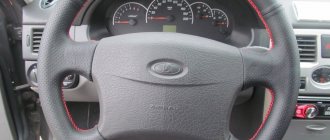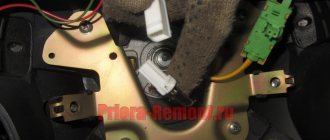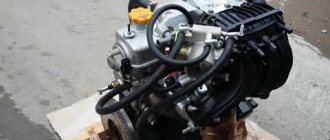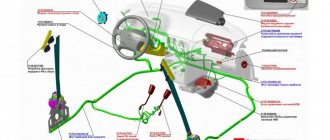VAZ-21214 (Lada 4×4) - modification of model 21213 with the VAZ-21214 engine (1.7 l, 82.8 hp, 127.5 Nm) equipped with central fuel injection. Since 2002, this model has been equipped with a VAZ-21214-10 (Euro-0) engine with distributed fuel injection, upgraded in 2006 to Euro-2 standards (21214-20), in 2008 to Euro-3 (21214- 30) and, finally, in 2011 to Euro-5 (for export) and Euro-4 (for domestic consumption) standards.
Independent, wishbone, coil springs, telescopic hydraulic shock absorbers and anti-roll bar
Dependent (rigid beam), on four longitudinal and one transverse arms, with coil springs and telescopic hydraulic shock absorbers
Disc stamped or made of light alloys
127J-406 (5Jx16) or 51/2Jx16 (only for light alloy wheels)
Reach, ET (distance from the disk mating plane to the middle of the rim), mm
58 or 48–58 (only for light alloy wheels)
Diagonal or radial
175-406 (6.95-16) – diagonal; 175/80R16 or 185/75R16 – radial
Exterior and interior of the new Lada
Technical characteristics of the car Lada (VAZ) 21703 (priora) (2007(2013)).
Lada 217030 technical specifications. 217030 Lada Priora The three-door Niva car in the Urban modification has been produced since October 2014, and the five-door version appeared in 2016.
AvtoVAZ President Bo Andersson decided to “rejuvenate” the mini-all-terrain vehicle, so popular in Russia, and present a more modern version in a new guise, distinguished not only by design, but also by higher comfort.
What changes have occurred in the exterior, how does the Lada Urban differ in appearance from the standard Niva?
The innovations are as follows:
- modernized, more aesthetically pleasing plastic bumpers were installed;
- exterior door handles painted black;
- the car is equipped with alloy wheels of increased radius (R16);
- side mirrors have become large and equipped with electric drive;
- new body colors added;
- The radiator grille has been slightly modified.
In general, there are not many external changes, but the interior of the car has become noticeably more interesting.
The interior features completely different seats with combined upholstery, a new 4-spoke steering wheel with horn buttons on the sides, and an instrument cluster manufactured by VDO.
The front seats are adjustable mechanically, but the steering column is tightly screwed on and is not adjustable at all.
The interior of the Lada 4x4 Urban has improved vibration and noise insulation, but noise from the gearbox and engine can still be heard.
The interior plastic and the panel itself are rigid; miniature air deflectors are still built into it.
Two cup holders have appeared on the console of the gearshift and transfer case levers, and the joystick for electric mirrors is also located here.
The console itself between the seats looks good, but it lacks an armrest with a bar.
Above the driver's head in the center of the cabin there is a new courtesy lamp with LED lighting; there are no mirrors in the sun visors.
The back row of seats is cramped for passengers; only children can fit comfortably here.
There are no rear headrests, the back of the sofa does not recline completely.
The volume of the luggage compartment of the “3-door” is 265 liters, with the backrest folded it increases to 585 liters.
The trunk release handle is located in the rear of the cabin on the left side, and there is also a handle on the outside of the trunk door.
There is also a shelf installed at the back, and a plastic mat is laid on the floor.
Berry always: Lada 4×4 with new interior and airbag
Snow in Moscow this winter is almost as incredible an event as the restyling of the Niva. But in mid-January they both happened. True, the snow melted quickly, and the Lada 4x4 only changed in the interior. But how!
Niva's improvements move approximately with its own dynamics - this is only the third front panel in forty-three years of production! Remember the first one with the fan of six scales? The salon was filled with soft, uncomfortable chairs and Zhiguli stove sliders. If you forgot, I found an early Niva especially for this test - look at the photos. Together with many units, the SUV adopted the Zhiguli's signature Italian squat stance and carefully carried it through all these decades. But in vain: for people taller than 180 cm, it was frankly inconvenient to drive the Niva - and many owners altered the fastenings of the sled in order to move the seat further away. In addition, a subframe for the transfer case with additional fastening was invented long ago to reduce vibrations, and successful camshaft options were selected, which allows you to change the dynamics from sad to sad. How did the plant respond to these examples of folk art?
At first glance, not at all. The restyled appearance has not changed, except for the fog lights that appeared on the Urban version. There are no fewer keys either - to open the doors and start the engine, you still need two of them. The old smell and the scary steering wheel the size of a mill wheel have been carefully preserved in the cabin - the Niva has had an excellent power steering for more than ten years, but the steering wheel still thinks that no one will help it turn the front wheels. And those unsightly steering column switches from Zhiguli cars?
However, the rest of the interior is good! After all, how was it before? Fractures instead of gaps, unpleasant quality and controversial design. And most importantly, the ergonomics of the Niva required strong muscle memory - to sit down in the dark interior in the evening and by touch find all the buttons and switches scattered across the panel in a chaotic manner. And now a light bulb is built into the round lighting handle, and a few buttons are grouped into clear blocks. Overhead there is a new molded ceiling with a bright shade. And finally, I no longer have to guess where and which lever to move so that warm air flows onto the windshield - I’m not afraid to admit that I was never able to master that Zhiguli artifact. Largely due to the fact that when I was six, my dad told me not to touch these handles under any circumstances, otherwise the heater radiator tap would leak.
The full version is available only to subscribersSubscribe now
I'm already subscribed
LADA 4X4 5-door (Lada Niva" 5-door)
Niva 2131: technical characteristics of a 5-door car
Lada 4x4 engine technical characteristics
The five-door Lada Niva 4x4 is a compact, unpretentious, reliable SUV designed for transporting passengers and luggage at air temperatures from -40 °C to +45 °C. This car is distinguished by a suspension that provides excellent ride comfort and absolute immunity to road irregularities. The five-door VAZ 2131 is the most spacious car in the Niva 4x4 line.
Dimensions, weight, load capacity
The vehicle has characteristics such as length, width, height. These indicators help the driver assess how much space the car occupies on the road. Length is the distance between the maximum protruding parts in front and behind. The width is determined by the boundaries of the side mirrors. Height is measured from the surface on which the vehicle is located to the highest point on the roof of the vehicle.
All this data is not difficult to find in the vehicle operating manual. Dimensions Niva 2131:
- length – 4240 mm;
- width – 1814 mm;
- height – 1640 mm.
For Niva 2131, the outer minimum turning radius along the axis of the front wheel track is 6.45 m. Equally important indicators are weight (curb weight) and load capacity. The first is the total mass of a set of standard equipment, all necessary consumables (including engine oil, fuel, etc.), as well as the weight of the driver. Baggage and passengers are not included. The 5-door Lada Niva 4x4 weighs 1370 kg.
What is the difference between Chevrolet Nivas of different modifications?
Niva is produced on the territory of the Russian Federation by specialists from GM-AvtoVAZ. The first concept, number 2123, was first demonstrated in 1998. The model was considered a successor to the VAZ-2121.
Restyling affected only the body. Spaciousness and modernity are its main advantages. The manufacturer's tasks included:
- providing complete comfort for the driver and passengers;
- increase in wheelbase.
Due to the 1998 crisis, car assembly was done manually. After purchasing the plant, General Motors in 2002 created a new look. The Niva was produced with a radiator, a golden cross and received a new name - Chevrolet Niva.
The SUV was produced in 2 main trim levels:
- L: electric windows, heated exterior mirrors (since 2004)
- GLS: faux leather interior, 16-inch alloy wheels, audio equipment, isothermal tinted windows, fog lights, heated front seats.
Interior equipment
For a domestic SUV, the interior looks good. True, the trim is made of rough plastic, the front seats are equipped with outdated adjustment systems, and the instrument panel could be more modern.
On the other hand, the car is designed for driving both in the city and in rural areas. It is worth noting the presence of air conditioning, power steering, front airbags and high-quality sound insulation. Three passengers can comfortably fit in the back. The front seating also does not cause any particular complaints. Folding rear seats allow you to transport the weight of the Chevrolet Niva up to 0.5 tons.
In general, the interior design is quite successful in terms of functionality. The main controls are located in easily accessible places, the seats are equipped with headrests and lateral support. The interior upholstery is made of practical and beautiful materials that are easy to clean. Transmission noise, although it penetrates the cabin, does not cause much concern. The overall impression of the interior is only positive for a domestic budget SUV.
Malfunctions, causes, elimination
Initially, engine 21214 has a characteristic failure - failure of 1 - 2 cylinders due to failure of the ignition module due to overheating. The coils and control switch burn out, and electrical equipment needs to be replaced. Other breakdowns are typical for most VAZ engines:
| At idle, the internal combustion engine is unstable and stalls. | 1) damage to the insulation of explosive wires 2) faulty spark plug 3) valve timing failure 4) compression decreased | 1) replacement of high-voltage beams 2) adjustment of the interelectrode gap, cleaning of carbon deposits 3) installation according to shaft marks 4) valve grinding, cylinder repair |
| XX speed decreased spontaneously | 1) production of DXX | 1) replacing the idle speed sensor |
| The engine stalls while driving in the heat | 1) the check valve is stuck 2) the hose or tube is pinched 3) the drain line has failed 4) steam plug in the supply system | 1) valve replacement 2) inspection and geometry correction 3) purging the line 4) purge and cleaning |
Fuel and drain line
Good old SUV
The Niva 21214 car has proven to be a successful project, combining the cross-country capabilities of an all-terrain vehicle and the comfortable elements of a passenger car.
It is perfect for weekend trips out of town, weekend trips for fishing or hunting. And even the considerable costs of using a vase cannot upset lovers of this particular car model.
https://youtube.com/watch?v=RZ8BzdKTke0
Before buying a car, you should understand what costs will be required to maintain it. Therefore, the manufacturer in the technical specifications indicates fuel consumption data in liters per 100 km. Let's find out what numbers are indicated in the Niva 4x4 documentation and what values are found in practice during the operation of an SUV.
On the official website AvtoVAZ indicates the following fuel consumption per 100 km for the Niva:
- Urban cycle - 12.1 l/100km
- Extra-urban cycle – 8.3 l/100km
- Mixed cycle – 10 l/100km
These values are the same for all Niva 4x4 injectors (3-door, 5-door and “Urban”).
The manufacturer notes that fuel consumption data was determined under standardized conditions using special measuring equipment, in accordance with the requirements of GOST R41.101–99 (UNECE Rules No. 101). Used to compare cars from different automakers. They are not an operational standard.
Currently, the Niva plant does not produce a carburetor engine, so the figures were found in the operation, maintenance and repair manual for the Niva VAZ 21213 for 2005. There is a detailed table with fuel consumption for this SUV:
| Options | VAZ-2129 | VAZ-2129-01 | VAZ-2130 | VAZ-2131 | VAZ-21312 | VAZ-2131-01 | VAZ-21312-01 |
| Engine | VAZ-21213 | VAZ-21213 | VAZ-21213 | VAZ-21213 | VAZ-2130 | VAZ-21213 | VAZ-2130 |
| Gasoline consumption per 100 km when driving in top gear, no more than, l | |||||||
| at a speed of 90 km/h | 10,3 | 10,3 | 10,3 | 9,1 | 9,3 | 9,1 | 9,3 |
| at a speed of 120 km/h | 11,8 | 11,8 | 11,8 | 12,1 | 12,3 | 12,1 | 12,3 |
| during urban driving cycle | 12,3 | 12,3 | 12,3 | 11,1 | 11,9 | 11,1 | 11,9 |
We also provide data on fuel consumption for different types of engines from Wikipedia:
- VAZ-2121 (carburetor): 10.8-13.4 l/100 km
- VAZ-21213 (carburetor): 8.3-11.5 l/100 km
- VAZ-21214 (injector): 8-9.1 l/100 km
Thus, fuel consumption on a Niva 4x4 (injector) is slightly less than with a carburetor. It is worth noting that reviews from owners of this SUV indicate that in practice the numbers may be higher. It is not uncommon to see fuel consumption of 14 l/100 km or even 15 l/100 km on a Lada 4x4.
How to reduce fuel consumption:
- Change your driving style, make acceleration smoother, and do not exceed speeds above 80..90 km/h.
- Drive more often on flat roads. On off-road, fuel consumption is significantly higher.
- Use additional electrical equipment of the car less often. For example, air conditioning, heated seats, etc.
- There may be problems with the engine. Perform diagnostics and troubleshoot problems.
- Fuel consumption on AI95 is less than on AI92.
It is worth remembering that high or increased fuel consumption is observed in winter, when the engine warms up for some time before driving.
What is the average fuel consumption on your Niva 4x4 SUV? Do you have any tips to help reduce these numbers? Let us remind you that fuel consumption also depends on the type of gasoline, so the majority of owners recommend using AI95.
The Niva's fuel consumption is always acceptable. The developers are seriously thinking about reducing fuel consumption for different brands of Niva.
Niva cars, despite their high fuel consumption, are in great demand among hunters and fishermen. If we compare the fuel consumption of UAZ and Niva, preference is given to Niva for lower fuel consumption. New UAZ cars with injectors should be given preference - the fuel consumption of these cars is 12-14 liters (in the urban cycle, using one axle).
The fuel consumption of a Niva depends on its modification (brand), driving style and time of year. The table below shows average fuel consumption for different brands of Niva.
Car Lada 212140 technical specifications
VAZ-21213 (the original name “Taiga” did not stick) is a restyled Niva model with a redesigned rear part of the body with a lower loading height (a different shape of the rear door and rear lights), a more powerful and high-torque VAZ-21213 engine (1.7 l , 81.8 hp, 125 Nm) with a Solex carburetor and a contactless ignition system (both reduce fuel consumption), an aluminum radiator, and much more. In 1993, a transitional batch was produced with a standard VAZ-2121 engine.
VAZ-21214 (LADA 4×4) - modification of model 21213 with the VAZ-21214 engine (1.7 l, 81.8 hp, 127.5 Nm) equipped with central fuel injection. Since 2002, this model has been equipped with a VAZ-21214-10 (Euro-0) engine with distributed fuel injection, upgraded in 2006 to Euro-2 (21214-20) and in 2008 to Euro-3 (21214- thirty). Since 2006, in accordance with the agreement on the GM-AvtoVAZ joint venture, it was renamed LADA 4x4 3-door..
VAZ-21215 is an export version with a Peugeot XUD 9SD diesel engine, produced in 1999-2007. The modification was produced in small series for export, so the standard assembly included an improved body kit (bumpers, spoilers, linings, alloy wheels, etc.).
VAZ-21216 is an export version of model 21213 with right-hand drive and a VAZ-21213 carburetor engine.
VAZ-21217 is an export version of model 21213, with a VAZ-21011 engine (1.3 l).
VAZ-21219 is a transitional combined modification with a body and suspension from the VAZ-2121 and a 1.7-liter engine and transmission from the VAZ-21213. The interior and rear window washer reservoir were also retained from the VAZ-2121. Produced in 1993-1994.
Many car enthusiasts claim that the domestic automobile industry is in complete ruin and there are no worthy companies producing normal cars. However, this is a complete misconception and our engineers, albeit infrequently, can produce products worthy of attention.
One of these is the NIVA Chevrolet all-wheel drive SUV from the VAZ automobile plant, which is in mass production.
In 2006, AvtoVAZ launched into mass production a new generation of NIVA Chevrolet, which used a more powerful power unit from Opel, in tandem with which the engineers decided to install a five-speed transfer-type manual transmission. This combination made it possible to significantly increase the power and dynamic characteristics of the SUV.
The electronic equipment of the car has also undergone significant changes. The vehicle has become more modern, comfortable and safe. The brake system is equipped with an anti-lock braking system, and the discs are equipped with ten-inch vacuum brake boosters.
To increase the reliability of protection and safety of life of the driver and front passenger, the developers equipped the SUV with two modern airbags. An active air conditioning system has been installed in the car interior, providing an optimal interior microclimate.
According to the technical data sheet of the car, the SUV is equipped with a gas tank designed for 58 liters of fuel, and if the supply of fuel decreases, the system will notify the driver using a special indicator located next to the dashboard.
However, it should be noted that due to the design of the fuel tank and its complex shape, a dead reserve of gasoline of about 7 liters is formed in it. When the light flashes, indicating the need to replenish the fuel supply. This usually happens when there are about 10 liters of gasoline left in the tank.
When refueling, the driver can add about 44 liters, which leads to the conclusion that the actual volume of the gas tank is more than 60 liters. However, it is also necessary to understand the fact that it is impossible to give an unambiguous answer to the question about the volume of the fuel tank due to certain explainable reasons.
Firstly, the gas tank sensor is an old model, so it is unable to show the real amount of fuel, and secondly, in the warm and cold months of the year, different amounts of gasoline are placed in the gas tank.
| Rated voltage, V | 12 |
| Accumulator battery | Capacity 55 Ah at 20-hour discharge mode |
| Generator | AC with built-in rectifier and voltage regulator, maximum output current 55 A at rotor speed 5000 min-1 |
| Starter | Direct current, with electromagnetic traction relay and freewheel. Power 1.3 kW |
*Measured using a special method.
** There are various modifications.
Options and prices
| Front and rear axle breather |
| Steel crankcase protection |
| Driver airbag |
| ISOFIX child seat anchors |
| Immobilizer |
| Daytime Running Lights |
| Emergency warning system ERA-GLONASS |
| Anti-lock braking system with electronic brake force distribution (ABS, EBD) |
| Rear seat headrests 2 pcs. |
| Front passenger airbag |
| Security alarm |
| Fog lights |
| On-board computer |
| 60/40 split folding rear seat |
| Seat upholstery is fabric. Black color |
| Sockets 12V, USB |
| Driver's seat armrest with cup holders |
| Seat upholstery is fabric. Color dark gray |
| Driver and passenger sun visor with mirror |
| Power steering |
| Height-adjustable steering column |
| Adjusting the height of the front seat belts |
| Cabin air filter |
| Light window tinting |
| central locking |
| Power windows for front doors |
| Electric drive and heated exterior mirrors |
| Audio preparation |
| Air conditioner |
| Cooled glove box |
| Driver's seat with height adjustment and lumbar support |
| Reinforced tinted rear windows |
| Folding key with remote control |
| Heated front seats |
| Heated windshield |
| Rear parking sensors |
| Rear View Camera |
| Multimedia system (7" color display with TouchScreen, FM/AM, USB, AUX, Bluetooth, Hands free, E-Link - screen display and control of Android smartphone*), 2 speakers, external antenna |
| Side door moldings |
| 15" steel wheels |
| Spare steel wheel for temporary use 15" |
| 15" alloy wheels |
| Bumpers in body color |
| Exterior mirrors in body color |
| Exterior door handles in body color |
| Railings |
| 16" alloy wheels |
| Spare wheel cover |
Options and prices of Niva 4x4 Bronto for 2019.
In the dealer network, the off-road Niva is available to customers in four trim levels. All modifications are equipped with the same old, but notable for its reliability, VAZ-21214 engine (1.7 l., 8 cl., 83 hp) and a five-speed manual gearbox. The cost of an improved SUV varies from 693 to 757 thousand rubles. The base includes: air conditioning, braking system with ABS, heated front seats, electric windows, electric drive and heated exterior mirrors.
| Execution | Standard | Standard image | ||
| Equipment | 70-050 | 70-051 | 70-052 | 70-053 |
| Price, rub.* | 693 thousand | 732 thousand | 718 thousand | 757 thousand |
| Plastic fenders | + | + | ||
| Rubber fenders | + | + | ||
| Plastic bumpers | + | + | ||
| Floor sill trims | + | + | ||
| Railings | + | + | ||
| PTF | + | + | ||
| Camouflage body paint | + | + | ||
Exterior Features
The relationship with its American counterpart can be guessed only by the emblems on the grille, body and steering column. This car belongs to the class of light SUVs of the SUV category. The weight of the Chevrolet Niva allows you to confidently overcome obstacles and stay firmly on the road.
The exterior of the car looks quite nice and modern. There is powerful engine protection, thoughtful axial weight distribution, small overhangs on the sides, as well as plastic body equipment. Everything, combined with optimal ground clearance, harmonizes perfectly and inspires respect. Short plastic bumpers and “squinted” light elements add additional aggression. The installed top roof rails on the Chevrolet Niva add practicality. Weight 100 kg – that’s how much you can transport on them.
Specifications
All technical capabilities of the model are determined by the only available power unit from AvtoVAZ. We are talking about a 1.7-liter engine capable of producing 83 horsepower and a maximum operating thrust of 129 Nm. This engine is paired with a 5-speed manual transmission and an all-wheel drive system, which has the ability to lock the center differential, as well as a downshift.
With this technical equipment, an SUV, regardless of the number of available seats in the cabin, will consume on average 9.9 liters of 95-octane gasoline per 100 km. The three-door Lada 4×4 Niva can accelerate to 100 km/h in 17 seconds, which is a very modest figure. For a five-seater model, this value will be even higher and is stated at 19 seconds. The maximum speed that an SUV can reach is 137 km/h.
The chassis of the SUV is represented by an independent suspension at the front, at the base of which there are double wishbones, and at the rear - springs. The braking system consists of disc brakes at the front and drum brakes at the rear.
Main parameters of the new Lada 4×4 Niva 2022:
- Body dimensions – 3740 x 1680 x 1640 (for a three-door model) and 4240 x 1680 x 1640 (for a five-seater SUV) mm.
- Weight – 1285 and 1425 kg.
- Number of places – 4-5.
- Ground clearance – 200 or 220 mm.
- The fuel tank capacity is 42 liters for the three-door version and 65 liters for the five-door version.
- Free space in the trunk is from 265 to 420 liters in the basic version.
Description
The geometric parameters of cross-country ability are good due to the fairly high ground clearance (220 mm), small body overhangs (approach angle 32, departure angle 37) and a relatively short 2.2-meter wheelbase.
VAZ-21214 (Lada 4×4) - modification of model 21213 with the VAZ-21214 engine (1.7 l, 82.8 hp, 127.5 Nm) equipped with central fuel injection. Since 2002, this model has been equipped with a VAZ-21214-10 (Euro-0) engine with distributed fuel injection, upgraded in 2006 to Euro-2 standards (21214-20), in 2008 to Euro-3 (21214- 30) and, finally, in 2011 to Euro-5 (for export) and Euro-4 (for domestic consumption) standards.
Niva's fuel consumption is acceptable!
The car is given good dynamics and acceptable fuel consumption by the Niva thanks to its reliable engine.
Niva of old brands is acceptable to most people; such cars consume a lot of fuel. The driver can enjoy all the delights of the Niva’s high cross-country ability at different times of the year. The Niva with the new engine demonstrates extreme efficiency, thanks to which the car has low fuel consumption and a very low level of harmful emissions into the atmosphere.
Niva's fuel consumption depends on the driving cycle.
The fuel consumption of a Niva car depends on the cycle - in the urban cycle, the Niva spends about 11 l/100 km, in the suburban mode (speed 90 km/h) it spends 8.7 liters of fuel, in mixed mode the Niva consumes 10.8 liters. Depending on the type of driving, the fuel consumption of a Niva vehicle may vary. The exhaust gases from the NIVA vehicle meet the requirements of the Euro-2 toxicity standard.
How to reduce fuel consumption of Niva?
Reducing fuel consumption in an old carburetor Niva - precise adjustment and repair of the Niva carburetor. This is a complex and delicate procedure that requires extensive knowledge of the carburetor and fuel system of the car. Carburetor repairs are performed by a special technician.
Reducing fuel consumption in new Nivas with injectors is done by new firmware of the controller - you are given a new economical program in which the parameters of the Niva fuel system and the ignition system are changed. The power and throttle response of the Niva engine may decrease when changing the program. Reducing the Niva's fuel consumption by installing a new program in the controller is performed by a diagnostician.
If the Niva's fuel consumption is very high, but the carburetor or injector settings are done correctly, pay attention to the wear of the Niva's piston group. High wear of piston rings, cylinder block and pistons will result in increased fuel consumption for the Niva
“>
Specifications
The five-door version of the 2022 Lada 4×4 Niva has 5 seats, and the three-door version can comfortably accommodate no more than 4 passengers. In addition, the “three-door” is 20 mm lower than its five-door “brother”, whose ground clearance is 220 mm. It is also not surprising that the weight of SUVs differs by 140 kg - the three-door version weighs 1,285 kg, while the weight of the five-door version is 1,425 kg.
The 50 cm difference in wheelbase also played a role in the dimensions of the cars. We will display their main indicators in a list. The standard three-door Lada 4×4 Niva has the following dimensions:
- wheelbase length - 2,200 mm;
- body length - 3,740 mm;
- width -1,680 mm;
- height - 1,640 mm.
The five-door model has the following dimensions:
- wheelbase length - 2,700 mm;
- body length - 4,240 mm;
- width - 1,680 mm;
- height - 1,640 mm.
As you can see, the width and height of both versions remain unchanged, while at the same time the weight, body length and wheelbase vary. Otherwise the cars are completely similar. They are based on a front fully independent double wishbone suspension. A dependent spring structure is installed at the rear. In addition, there are two anti-roll bars. The braking system is based on front disc and rear drum mechanisms. And for easier maneuvers on the road, a special power steering is installed.
An in-line 4-cylinder naturally aspirated engine with a power of 83 hp is installed in the engine compartment. and 129 Nm of torque. It is paired with a 5-speed manual gearbox, which redirects power to the permanent all-wheel drive system. According to the automaker's recommendations, AI-95 gasoline is required for normal operation of the power unit. The SUV tank holds 42 liters in the three-door version and 65 liters in the five-door version. It is worth noting that the main advantage of the latter is the larger volume of the luggage compartment - 420 liters in the standard position versus 265 liters for the three-door.
Fuel consumption (city) 12.1 l Fuel consumption (highway) 8.3 l Fuel consumption (mixed) 9.9 l Fuel type Gasoline Acceleration 0-100 km/h 17 s Top speed 142 km/h
Power 83 hp at 5000 rpm. Torque 129 Nm at 4000 rpm. Engine location Front, longitudinal Engine capacity 1690 cm 3 Number of cylinders 4 Cylinder position In-line Fuel system Direct injection Turbine no
Video review of Niva 4×4 Bronto
VAZ 21214 is a passenger car, characterized by increased cross-country ability, equipped with a five-speed gearbox and a transmission with permanent all-wheel drive. In addition, there is a two-stage transfer case. Body type - “Hatchback”, the morally and technically outdated “four-speed” gearbox, which was equipped with previous models, was replaced on 21214 by a more modern and functional five-speed gearbox.
Advantages and disadvantages of a car
Niva 2131 has proven itself not only in Russia, but also abroad. Car owners have identified both positive and negative characteristics of this car.
| Advantages | Flaws |
| Relatively low price compared to foreign SUVs. | Poor body resistance to corrosion. |
| Spacious salon. | Poor sound insulation. |
| Spacious trunk. | |
| The reliable chassis withstands extreme use on a wide variety of roads and terrain. | |
| High maintainability. |
In modern models of this SUV, anti-corrosion protection has become more effective, and the crosspieces in the cardan have been replaced with CV joints (constant velocity joints). The Lada Niva 2131 4x4 SUV is a legendary all-terrain vehicle that confidently overcomes off-road conditions. Differential all-wheel drive, front independent suspension, and the presence of a reduction gear are just some of the advantages of this car. The vehicle is perfect for both urban and rural areas.
Description of the car
Serial production of the VAZ 2121
began on April 5, 1977.
The car became the world's first SUV with a monocoque body and permanent all-wheel drive. The VAZ 2121 (Niva)
has small dimensions, unusual for an SUV, and a compact three-door hatchback body with a tiny trunk.
This design is explained by the fact that AvtoVAZ designers initially received the task of developing a compact city car. However, during development, the concept changed, and it was decided to convert the city car into a jeep. The development turned out to be extremely successful, because... The VAZ 2121
turned out to be compact compared to jeeps of that time, and, accordingly, much lighter. This affected the cross-country ability of the car, which had a rigidly connected all-wheel drive.
In addition, the interior of the car was not much different from the interior of a passenger car, because parts from the VAZ 2106 were widely used in the interior. Due to the high ground clearance, excellent cross-country capabilities and a completely modern interior for those years, the car received truly popular love. And currently the VAZ 2121 is in great demand.
Technical characteristics of Lada 4×4 Standard1)
Body
- Body type: mid-size SUV
- Car class: J
- Length/width/height, mm: 4220/1680/1640
- Wheelbase, mm: 2700
- Number of seats: 5
- Number of doors: 5
- Trunk volume minimum/maximum, l: 420/780
- Curb weight, kg: 1350
- Load capacity, kg: 500
- Gross weight, kg: 1850
- Ground clearance, mm: 228
- Fuel tank volume, l: 65
Engine and transmission
Engine type: petrol
with electronic throttle drive
- Location and number of cylinders: in-line 4-cylinder
- Working volume, cm 3: 1690
- Maximum power: 80 hp at 5000 rpm
- Maximum torque: 127.5 Nm at 4000 rpm
- Toxicity standards: Euro IV
- Fuel type: AI-95
- Box type: mechanical
- Number of gears: 5
- Downshift: present
- Drive type: permanent all-wheel drive
- Differential lock: center
Maximum speed, km/h: 142 Acceleration time 0-100 km/h, s: 16.4 Fuel consumption, l/100 km: urban: 12.6 suburban: 9.7 mixed: 11.3
Chassis
Front suspension: independent, spring, double wishbone
with dynamic vibration damper
Rear suspension: dependent, spring, trailing arms Ground clearance adjustment: none Adaptive suspension: none Front brakes: disc
diagonal brake pattern
Rear brakes: drum
diagonal brake pattern
Wheels and tires: steel 185/75 R16 Spare wheel: full size
Active safety
- Anti-lock braking system (ABS): none
- Brake Assist (BA): none
- Electronic Brake Force Distribution (EBD): None
- Traction control (ASR): none
- Stabilization system (ESP): absent
- Driver condition monitoring system: none
- Blind spot monitoring system: none
- Lane crossing warning system: none
- Traffic sign recognition system: none
Passive safety
- Front airbags: none
- Side airbags: none
- Side curtain airbags: none
- Knee airbags: none
- Belt pretensioners: none
- Active head restraints: none
- Child seat anchors (IsoFix): none
- Pedestrian safety system: none
Salon / Comfort
- Climate system: heater (stove)
- On-board computer: absent
- Seat upholstery: tweed
- Door trim: molded plastic
- Front panel finish: plastic
- Center console trim: plastic
- Steering wheel finish: polyurethane
- Gearbox trim: polyurethane
Glass and mirrors
- Heated windshield: no
- Athermal glass: absent
- Power windows: none
- Tinted windows: none
- Window blinds: side: no, back: no
- Wind deflector: none
- Side mirrors: manual adjustment
- Self-dimming rearview mirror: none
- Hatch: absent
Seats
- Seat height adjustment: none
- Lumbar support: no
- Electric seats: no
- Seat heating: no
- Seat ventilation: none
- Air scarf system: none
- Massage: none
- Folding rear seats: none
- Third row of seats: absent
- Armrests: none
- Rear head restraints: none
- Seat type: standard
- Steering wheel adjustment: mechanical
- Heated steering wheel: no
- Control of vehicle functions on the steering wheel: absent
- Steering wheel audio control (remote control): absent
- Steering wheel gearbox control: absent
- Power steering: present
A very useful and interesting article about NIVA and its MODIFICATIONS
The geometric parameters of cross-country ability are good due to the fairly high ground clearance (220 mm), small body overhangs (approach angle 32, departure angle 37) and a relatively short 2.2-meter wheelbase.
VAZ-21214 (Lada 4×4) - modification of model 21213 with the VAZ-21214 engine (1.7 l, 82.8 hp, 127.5 Nm) equipped with central fuel injection. Since 2002, this model has been equipped with a VAZ-21214-10 (Euro-0) engine with distributed fuel injection, upgraded in 2006 to Euro-2 standards (21214-20), in 2008 to Euro-3 (21214- 30) and, finally, in 2011 to Euro-5 (for export) and Euro-4 (for domestic consumption) standards.
From the general description we move on to specifics. So, Niva 21214 technical specifications:
- With three doors, one of which is the trunk hatch, the car is ready to accommodate four passengers.
- Body type - station wagon.
- Curb weight is 1210 kilograms, while the total weight is 1610 kg.
- The maximum speed that the car can reach is 137 km/h.
- To accelerate from 0 to 100 kilometers, the model will take 17 seconds.
- The minimum trunk volume is 260, and the maximum is 980 liters.
The characteristics of the VAZ 2121 Niva also arouse great interest among car enthusiasts, so let’s take a look at it right now. The body is all-metal, load-bearing type. It is considered a three-door model if you take into account the luggage compartment hatch. The driver and front passenger seats are equipped with headrests and can be adjusted in height and tilt. If you need to increase the trunk volume, you can fold the back of the rear sofa. At the owner's request, the car can be equipped from the factory with a washer and heated rear window.
VAZ-2121 “Niva” (export name Lada Niva 4×4) - the base model with the VAZ-2121 engine (1.6 l, 75 hp, 116 Nm) and 4-speed. Checkpoint. Several prototypes of the VAZ-E2121 were created in 1972-1975. At the end of 1976, a pilot production batch of Niva was produced. The model was serially produced from April 1977 to 1993.
VAZ-21211 (Lada Niva 1.3) - export modification with the VAZ-21011 engine (1.3 l, 69 hp, 92 Nm). Produced since 1978 for countries with increased taxes on engines with a volume of more than 1500 cm³ (mainly the Benelux countries and Southern Europe). It was in limited demand due to the low torque of the engine off-road and poor dynamics on regular roads.
VAZ-21212 (Lada Niva 4×4) - export right-hand drive modification. Produced in limited quantities, primarily for the English market. It is known about the sale of a small batch of right-handed Nivas to Japan, where Soviet cars had neither previously nor later penetrated.











